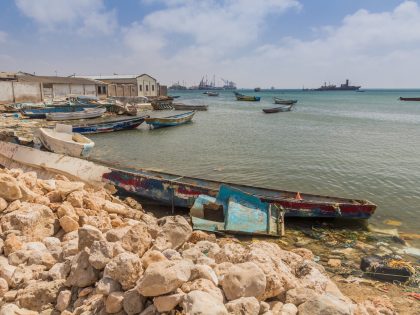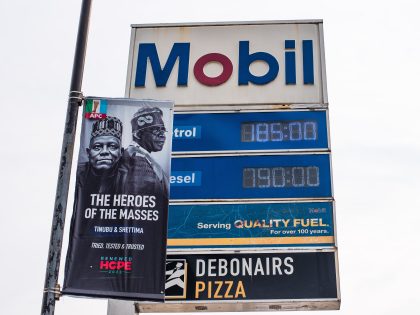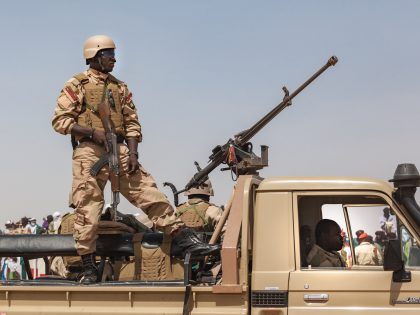The collapse of oil for insecurity
Why Venezuela’s turmoil and the Khashoggi crisis portend an even darker geopolitics of oil.

Image: United States Marine Corps, via Flickr CC.
The crisis in US-Saudi relations triggered by the state sponsored murder of Saudi journalist Jamal Khashoggi might seem unrelated to Venezuela’s current turmoil.
Commentary on both crises has of course noted the centrality of oil. Whereas Venezuela’s civil conflict allegedly stems from mismanaged oil revenues, the Khashoggi crisis is represented as a consequence of Washington’s tragic “oil for security” deal with Saudi Arabia, the idea that the US reluctantly but imperatively protects the region’s oil and, in return, the Saudis buy US weapons to keep thousands of defense workers employed.
In many ways, however, both of these crises are related to a greater crisis, the growing crisis of oil’s “overabundance.” As such, these crises call into question the possible collapse of political and economic arrangements created in the 1970s that have been disrupted by a recent technological revolution in US oil extraction. For four decades, hyper-militarization and permanent war in the Middle East and North Africa were the primary conditions that allowed wealth and power to be extracted from oil. These means — oil-for-insecurity — no longer appear to be working.
What “oil for security”?
“Oil for security” represents a powerful but flawed narrative of US relations towards the greater Middle East for a number of reasons. First, there’s no documentary evidence that any such deals formally exist, as political historian and Saudi specialist Robert Vitalis has argued.
Second, oil-for-security narratives don’t add up. Washington was much more directly involved in the day-to-day security of the Saudi, Iranian, and Libyan monarchies in the 1950s and 1960s, well before the US became dependent on foreign oil. In Libya, British and US “protection” preceded oil production by over a decade. Washington has also shown just as much commitment to Morocco, Tunisia, Egypt, Israel, Turkey, and Pakistan, countries with little or no oil production. During the Cold War, Morocco received more US military aid than any other country in Africa besides Egypt.
Third, oil-for-security has been a losing proposition for almost everyone involved. The Iraqi, Iranian, and Libyan monarchies were all overthrown and replaced by regimes that openly challenged Washington’s policies. More recently, the US army concluded that Iran was the only country to benefit from the 2003 invasion and occupation of Iraq. By 2014, the American occupation of Afghanistan had already cost more than the Marshall Plan, and yet the Trump administration now seems set to withdraw on almost the same peace terms that the Taliban offered before the 2001 invasion.
Nor has oil-for-security been very good for the region’s security. Today the Middle East boasts three of the five deadliest conflicts since the end of the Cold War, and since 2012 it has witnessed more deaths from armed conflict than all other regions of the world combined.
Fourth, oil-for-security narratives obscure the ideological nature of US policies. In the 75-year history of America’s “awkward entanglements” and “unfortunate interventions” in the Middle East, Washington has never once found itself durably if regrettably allied to any of region’s oil-producing populist socialist republics like Algeria, Libya, Syria, Iraq, or Iran. It hardly needs to be said that these were in fact the regimes Washington most often contained, confronted, or changed through force.
Finally, energy security does not require oil-for-security entanglements. China has managed to develop the world’s largest economy and now boasts the planet’s largest fleet of motor vehicles, all without invading or occupying a single oil producing country.
Oil for Insecurity
The problem with “oil for security” theories is the common assumption that oil politics is defined by oil’s natural scarcity. Hence the frantic efforts to control it, especially in the Middle East and North Africa. But as historian Timothy Mitchell has demonstrated, oil’s role in the making of the modern world has been defined by the exact opposite problem: there’s always been too damn much. The ability of companies to extract wealth from oil and the ability of governments to draw power from it has always depended on creating a sense of oil’s scarcity.
In the early decades of oil, profits and power were created through domestic monopolies and collusion between imperial powers. After World War Two, a cartel of the dominant North Atlantic oil firms colluded with their home governments to managed oil’s scarcity. This system gradually came into crisis in the 1950s and 1960s. The major producer states began to demand more equitable profit sharing agreements and more involvement in the technological, scientific, and managerial aspects of extracting, refining, and exporting oil. Soon ownership of oil reserves and infrastructures were being aggressively renegotiated, if not outright nationalized, across the postcolonial world.
This crisis of Western power and corporate profitability in the late 1960s was resolved when a new means of manufacturing oil’s scarcity emerged in the Middle East and North Africa: war. In the wake of the 1967 and, more importantly, the 1973 Arab-Israeli wars, the major international oil companies saw their relative rates of profit surge. This scarcity had nothing to do with the so-called Arab oil embargoes. Rather, it was the power of permanent insecurity in the Middle East and North Africa to induce a global sense of scarcity, and so raise prices.
By the end of the 1970s, a constellation of new and exacerbated conflicts had developed from the western edge of the Sahara desert to the western Himalayas. With the world’s major oil reserves under constant threat from political instability, permanent war and hyper-militarization had the effect of creating unprecedented rates of profit.
All of this was a happy coincidence for the oil companies. The real drivers of permanent insecurity across the Middle East and North Africa stemmed from two other developments: one, Washington’s post-Vietnam policy of indirect control, proxy wars, and Communist containment in the postcolonial world (e.g., the Safari Club); and two, the imperative to find new markets and sources of financing for weapons manufacturers. The geographical confluence of these interests in the Middle East and North Africa could be more accurately described as oil for insecurity.
The Nixon, Ford, Carter, and Reagan administrations consistently pursued policies that destabilized the Middle East. Wars in Western Sahara, Chad, Iran-Iraq, and Afghanistan were all deliberately exacerbated; pariah regimes in Iran and Libya were aggressively confronted; and conservative authoritarian allies in Morocco, Tunisia, Egypt, Turkey, Saudi Arabia, and Pakistan were lavishly rewarded with weapons and aid.
Flush in petrodollars, regimes across the Middle East responded to the intensification of inter-regional rivalries by equipping themselves with either North Atlantic or Soviet-made weapons depending on their Cold War (non)alignment. For North Atlantic arms manufacturers, oil-for-insecurity was also the solution to their own post-Vietnam crisis of profitability. In 2017 dollars, Middle East arms imports went from $7.5 billion in 1971 to over $30 billion in just six years. By the end of the 1970s, Middle East represented the vast majority of countries whose military expenditures registered as ten percent or more of GDP. The ten countries with the highest ratio of military expenditures to central government expenditures in 1982 were all in the Middle East. Today, most governments in the region continue to outpace all other “middle income” countries in terms of military spending and arms imports.
As economists Jonathan Nitzan and Shimshon Bichler have consistently demonstrated in a series of studies spanning over three decades, the relative profitability of the major oil and armament companies since the late 1960s has been closely tied to instability across the region.
The Crisis of Overabundance
Though the Islamic State’s resurgence in Syria, Iraq, and Libya from 2014 onward seemed to indicate an intensification of regional instability in a number of key oil producing zones, the relative profits of the major petroleum companies actually entered a period of unprecedented decline. So what happened?
In the fifty years since the 1967 Arab-Israeli war, there have been two cycles of scarcity and abundance driven by permanent insecurity in the Middle East and North Africa: the first from the mid-1970s through the 1990s; the second from 2001 to now.
The first cycle of oil-for-insecurity pushed oil prices to unprecedented levels in the late 1970s and early 1980s, which incentivized new frontiers and technologies of extraction (e.g., Alaska and the North Sea). An increasing glut of oil worldwide followed. Prices finally crashed in 1986, taking the Soviet Union down with them.
The end of the Cold War soon became a period of sustained crisis for the major oil and arms companies. It was a world of base closures, reduced Pentagon budgets, and Middle East peace processes (e.g., Western Sahara and Palestine). As the neoliberal Democratic Party sidelined labor and embraced those sectors within capitalism that thrive on peace and security (tech and services), the reactionary political forces of the neoconservative movement doubled down on the old alliance of oil, arms, and Middle Eastern insecurity to restore their political fortunes. The Bush-Cheney administration’s invasions of Afghanistan and Iraq were in fact stunning successes in one respect: the peace crisis of the 1990s was ended and relative profitability was restored to oil and defense.
The major oil producing states — those not engulfed in war or under US sanctions — transformed these profits into political power. An ironic example was Venezuela. Hugo Chávez’s ability to conduct one of the most ambitious experiments in socialist populism since the end of the Cold War was made possible by the very imperialism he regularly denounced.
But the success of oil-for-insecurity from 2001 to 2012 proved to be its unmaking. New yet expensive technologies for onshore and offshore extraction, above all, hydraulic fracturing (“fracking”), seemingly became financially viable as oil prices finally returned to levels not seen since 1980. Production in the United States began to surge. And so this is how the second cycle of oil-for-insecurity, like the first, created the conditions of its undoing — by producing too damn much.
Chávez, who died in 2013, would not live to see the 2014 collapse in oil prices and the squandering of his legacy under Nicolás Maduro. But like all political and corporate leaders who had grown dependent on oil-for-insecurity, Maduro struggled to adapt to a new reality of implacable overabundance. Nor did it help that US sanctions have made it impossible for Venezuela to restructure its debt.
Today’s overabundance crisis has proven exceptionally resilient. Civil wars in Syria, Iraq, Libya, and Yemen were intensified by foreign interventions in 2014 and 2015 yet prices continued to crash. More recent effort to raise prices through traditional mechanisms — OPEC-Russia quotas and sanctions on Iran and Venezuela — have so far proven ineffective. As fracking becomes cheaper, efforts to restrict oil and so raise prices appear to be automatically offset by increased output from North America.
The demise of oil-for-insecurity raises questions as to the kinds of strategies that will emerge to adapt to this new reality. It is tempting, after all, to think that we are seeing early iterations of a new politics of overabundance in the neo-authoritarianism of Putin and Trump. That might be giving them too much credit, however. There are still immensely formidable incentives in the world today — at the level of corporate profits and political power — to see major oil producing states like Venezuela cut off from markets through sanctions, civil conflict, or both. Hence the world should be concerned when it sees leaders in Washington and Moscow effectively colluding to exacerbate Venezuela’s crisis.



















